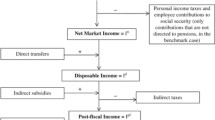Abstract
It is widely asserted that debt relief for heavily indebted poor countries (HIPC) could create and sustain a virtuous circle of poverty reduction and growth, primarily by providing additional fiscal resources for poverty alleviation. Debt relief targeted for human capital accumulation through increased public spending on education is viewed as a critical component of this link.1 Low overall educational attainment, stagnant school enrolment rates, along with high estimated returns to schooling in many HIPCs, are often cited as justification for increased public investment in education (Table 11.1). As a result, explicit targets for expanding school enrolment rates and other performance criteria for education expenditures have been set in HIPC programmes.
Access this chapter
Tax calculation will be finalised at checkout
Purchases are for personal use only
Preview
Unable to display preview. Download preview PDF.
Similar content being viewed by others
References
Auerbach, A. and L. Kotlikoff (1987). Dynamic Fiscal Policy. Cambridge: Cambridge University Press.
Barro, R. (1991). ‘Economic Growth in a Cross Section of Countries’, Quarterly Journal of Economics. 105(2): 407–43.
Barro, R. and J. Lee (2000). ‘International Data on Educational Attainment: Updates and Implications’, NBER Working Paper Series, 7911, Cambridge, MA: National Bureau of Economic Research.
Behrman, J. and N. Birdsall (1983). ‘The Quality of Schooling: Quantity Alone Is Misleading’, American Economic Review. 73: 928–46.
Ben-Porath, Y. (1967). ‘The Production of Human Capital and the Life Cycle of Earnings’, Journal of Political Economy. 84: 449–72.
Blunch, D. and N. Verner (2000). ‘Revisiting the Link Between Poverty and Child Labor: The Ghanaian Experience’, World Bank Working Paper, 2488, Washington, DC: World Bank.
Canagarajah, S. and H. Coulombe (1997). ‘Child Labor and Schooling in Ghana’, World Bank Policy Research Working Paper, 1844, Washington, DC: World Bank.
Card, D. and A. Krueger (1992). ‘Does School Quality Matter? Returns to Education and the Characteristics of Public Schools in the United States’, Journal of Political Economy. 100: 1–40.
Collins, S. and B. Bosworth (1996). ‘Economic Growth in East Asia: Accumulation versus Assimilation’, Brookings Papers on Economic Activity. 2: 135–203.
Deaton, A. (1991). Understanding Consumption. Oxford: Clarendon Press.
Demery, L., S. Chao, R. Bernier and K. Mehra (1995). ‘The Incidence of Social Spending in Ghana’, PSP Discussion Paper, 82, Washington, DC: World Bank.
Driffill, E. and H. S. Rosen (1983). ‘Taxation and Excess Burden: A Lifecycle Perspective’, International Economic Review. 24: 671–83.
Duflo, E. (2002). ‘The Medium Run Effects of Educational Expansion: Evidence from a Large School Construction Program in Indonesia’, NBER Working Paper Series, 8710, Cambridge, MA: National Bureau of Economic Research.
Foster J., J. Greer and E. Thorbecke (1984). ‘A Class of Decomposable Poverty Measures’, Econometrica. 52(3): 761–6.
Glewwe, P. (1996). ‘The Relevance of Standard Estimates of Rates of Return to Schooling for Educational Policy: A Critical Assessment’, Journal of Development Economics. 51: 267–90.
Glomm, G. (1997). ‘Parental Choice of Human Capital Investment’, Journal of Development Economics. 53: 99–114.
Hanushek, E. (1996). ‘Schooling, Labor Force Quality and Economic Growth’, NBER Working Paper Series, 5399. Cambridge, MA: National Bureau of Economic Research.
Heckman, J. (1999). ‘Accounting for Heterogeneity, Diversity and General Equilibrium in Evaluating Social Programs’, NBER Working Paper Series, 6230, Cambridge, MA: National Bureau of Economic Research.
Hurd, R. (1989). ‘Issues and Results from Research on the Elderly’, NBER Working Paper Series, 3018(1–3), Cambridge, MA: National Bureau of Economic Research.
Judson, R. (1998). ‘Economic Growth and Investment in Education: How Allocation Matters’, Journal of Economic Growth. 3: 337–59.
Lord, W. (1989). ‘Transitional from Payroll to Consumption Receipts with Endogenous Human Capital’, Journal of Public Economics. 38: 53–73.
Mackinnon, J. and R. Reinikka (2000). ‘Lessons from Uganda on Strategies to Fight Poverty’, World Bank Working Paper, 2440, Washington, DC: World Bank.
Psacharopoulos, G. and H. A. Patrinos (2000). ‘Returns to Investment in Education: A Further Update’, World Bank Working Paper, 2881, Washington, DC: World Bank.
Psacharopoulos, G., S. Morly, A. Fiszbein, L. Haeduck and B. Wood (1992). Poverty and Income Distribution in Latin America: The Story of the 1980s. Washington, DC: World Bank.
Senhadji, A. (2000). ‘Sources of Economic Growth: An Extensive Growth Accounting Exercise’, IMF Staff Papers, 47(1): 129–57, Washington, DC: IMF.
Editor information
Editors and Affiliations
Copyright information
© 2004 The United Nations University
About this chapter
Cite this chapter
Dabla-Norris, E., Matovu, J.M., Wade, P.R. (2004). Debt Relief, Demand for Education and Poverty. In: Addison, T., Hansen, H., Tarp, F. (eds) Debt Relief for Poor Countries. Studies in Development Economics and Policy. Palgrave Macmillan, London. https://doi.org/10.1057/9780230522329_11
Download citation
DOI: https://doi.org/10.1057/9780230522329_11
Publisher Name: Palgrave Macmillan, London
Print ISBN: 978-1-4039-3495-6
Online ISBN: 978-0-230-52232-9
eBook Packages: Palgrave Economics & Finance CollectionEconomics and Finance (R0)




